Giant ancient fish that likely preyed on humans' ancestors unearthed in South Africa


About 350 million years ago, long before the dinosaurs stalked the planet, a gigantic fish with deadly fangs hunted river waters on the ancient southern supercontinent Gondwana, a new study finds.
This fish, measuring up to 9 feet (2.7 meters) long, is the largest bony fish on record from the Late Devonian (383 million to 359 million years ago) and was predatory, prompting researchers to call it Hyneria udlezinye, or the "one who consumes others," in IsiXhosa, a widely spoken Indigenous language in the region of South Africa where the bones were found.
"Picture a huge predatory fish, easily topping 2 meters [6.5 feet] in length and looking somewhat like a modern alligator gar but with a shorter face like the front end of a torpedo," study co-author Per Ahlberg, a professor in the Department of Organismal Biology at Uppsala University in Sweden, told Live Science. "The mouth contained rows of small teeth, but also pairs of large fangs which could probably reach 5 centimeters [2 inches] in the largest individuals."
Researchers discovered the first clues of the ancient fish's existence in 1995, when they unearthed a series of isolated fossilized scales at an excavation site called Waterloo Farm near Makhanda (formerly known as Grahamstown), in South Africa. Now, in a study published Wednesday (Feb. 22) in the journal PLOS One, the researchers have finally pieced together a skeleton of the newfound species of giant tristichopterid, a type of ancient bony fish.
"It's been a long journey ever since then, assembling the answer to where these scales came from," study co-author Robert Gess, a paleontologist and research associate at the Albany Museum and at Rhodes University in South Africa, told Live Science.
Related: 'Never seen anything like it': Impeccably preserved Jurassic fish fossils found on UK farm
The skeleton reveals that H. udlezinye was a voracious predator. "The fins are mainly towards the back of the body. This is an ecological characteristic of a lie-in-wait predator; it can put on a sudden spurt. Hyneria would have lurked in the dark shadows and waited for passing things," Gess said. "It's the one that consumed others."
The giant fish probably preyed on four-legged creatures known as tetrapods, the ancestral group that led to the human lineage. "The tristichopterids evolved into monsters that, in all likelihood, ate [our ancestors]," Ahlberg said.
Previous research identified another species of the same genus, H. lindae, at an excavation site in Pennsylvania, which was part of the supercontinent Euramerica during the Late Devonian.
The fossils from Waterloo Farm are the first to indicate that Hyneria lived in Gondwana. The new study also reveals that giant tristichopterids lived not just in the tropical regions of Gondwana, but across the continent and even in the polar circle.

Most tristichopterid fossils found to date have been excavated in Australia, skewing our perception of the distribution of these animals. Other regions which belonged to Gondwana, like Africa and South America, are less well researched.
"Because Australia was in the tropics, and because all the well-sampled sites from this period and from Gondwana happen to be in Australia, there was a feeling that these giant tristichopterids originated in what is now Australia — along the tropical coast of Gondwana," Gess said.
RELATED STORIES
—Great white-shark-sized ancient fish discovered by accident from fossilized lung
—'Hell fish' likely killed by dinosaur-ending asteroid is preserved in stunning detail
—'Wonderfully-shaped feces' found inside ancient fish skull. What left the pretty poops?
Now, for the first time, researchers have found the remains of a giant tristichopterid in what would have been a polar region at the time. "We have this guild of ginormous predatory fish and this is the only example we have from the polar regions," Ahlberg said.
Tristichopterids disappeared in a mass extinction event at the end of the Devonian, about 359 million years ago. They have no direct descendants today, but researchers think that a common ancestor with our ancestral lineage existed earlier in the Devonian. "Late Devonian tristichopterids are more our second cousins than our direct ancestors," Ahlberg said.

